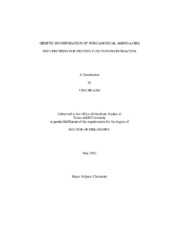| dc.description.abstract | With the objective to functionalize proteins for the understanding of their biological roles and developing protein-based biosensors, I have been developing methods to synthesize proteins with defined modifications and applying them to study protein functional roles and generate proteins with new properties. These methods rely on the read-through of an in-frame stop codon in mRNA by a nonsense suppressor tRNA specifically acylated with a noncanoncial amino acid (NAA) by a unique aminoacyl-tRNA synthetase and the genetic incorporation of this NAA at the stop codon site. NAAs either provide chemical handles for site-specific manipulation or mimic the posttranslational modifications, which are critical for understanding cellular regulations and signal transduction.
The pyrrolysine synthetase (PylRS) has been wildly used to incorporate NAAs into proteins in E. coli. Taking advantage of PylRS, I have developed method to genetically incorporate ketone-containing N--acetyl-L-lysine analog, 2-amino-8-oxononanoic acid (KetoK), into proteins for their site-specific modifications and used it to mimic the protein lysine acetylation process.
I have also modified the ribosome in order to improve the amber suppression efficiency and therefore to achieve incorporation of multiple copies of NAA into one protein. By overexpressing a truncated ribosomal protein, L11C, I have demonstrated 5-fold increase of amber suppression level in E. coli, leading to higher expression levels for proteins incorporated with NAAs. I have also demonstrated this method can be applied successfully to incorporate at least 3 NAAs into one protein in E. coli.
With the success of incorporating multiple NAAs into one protein, I have further introduced two distinct NAAs into one protein simultaneously. This is done by using a wild type or evolved PylRS-pylTUUA pair and an evolved M. jannaschii tyrosyl-tRNA synthetase (MjTyrRS)-tRNACUA pair. By suppressing both UAG and UAA stop codons in one mRNA, a protein incorporated with two NAAs is synthesized with a decent yield.
There is of great interest to incorporate new NAAs into proteins, which is done by library selection. By introducing both positive and negative selective markers into one plasmid, I have developed a one-plasmid selection method. In this method, the positive and negative selections are accomplished by in a single type of cells hosting a single selection plasmid. | en |


